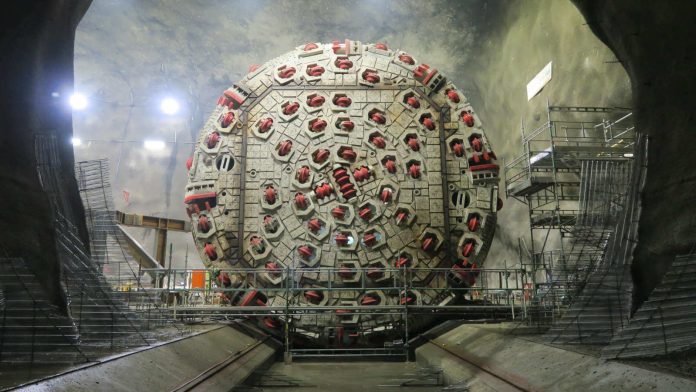From the Hades of Greek mythology to Jules Verne’s hollow earth, the subterranean world has always fascinated humanity. It has been a source of valuable minerals and the scene of powerful volcanic eruptions. Today, the underground also hosts an intricate network of transport routes that alleviate urban traffic congestion and enable rail systems to function without disrupting surface landscapes. Many of these tunnels owe their existence to tunnel boring machines (TBMs)—massive mechanical worms that harness cutting-edge technology to navigate the hostile environments of the subterranean realm.
In this article, you will learn about the following topics:
What are tunnel boring machines?
A tunnel boring machine (TBM) is a specialized machine designed for excavating tunnels. Resembling giant metal worms, they feature a cutting head at the front capable of excavating at speeds exceeding one meter per hour. TBMs enable the efficient excavation of large volumes of material with exceptional precision, minimizing surface disruptions and reducing the risks associated with underground construction.
These machines are enormous and complex to operate. For context, the largest TBM measures 120 meters in length, with a cutting head 17 meters in diameter and a weight of approximately 5,000 tonnes.
Main components of a tunnel boring machine
TBMs are intricate and massive, pushing the boundaries of industrial vehicle engineering. Beyond the control systems and the operator’s cabin, these are their key components:
- Cutting head. The rotating front section equipped with cutting discs or specialized tools for excavating the ground.
- Shield. A metallic structure that protects the machine and its operators while ensuring tunnel stability during excavation.
- Propulsion system. Hydraulic jacks that propel the TBM forward as it progresses.
- Segmentation frame. Places precast concrete segments (known as linings) to reinforce the tunnel walls as excavation continues.
- Debris support and evacuation system. Extracts and transports excavated material, such as rock and soil, out of the tunnel.
5 types of tunnel boring machines (and their game-changing projects)
Since the late 20th century, tunnel boring machines have played a critical role in major underground infrastructure projects worldwide. Over time, various TBM models have been developed to tackle specific challenges. Here are five key types and the iconic projects where they proved their worth.
Earth pressure balance (EPB)
EPBs are ideal for soft, mixed, and sandy soils where maintaining constant pressure is essential to prevent ground collapse. These widely used machines enable precise excavation and stabilize the working face, minimizing surface disruption.
Line 6 of the São Paulo subway, Brazil (2021-2025). Two TBMs, each 10.6 meters in diameter and weighing 2,000 tonnes, were equipped with advanced technologies to navigate São Paulo’s challenging urban geology.
Double shield TBMs
Designed for heterogeneous and rocky terrains, double shield TBMs feature two protective shields to ensure safety and precision during excavation.
Follo Line, Norway (2016-2022). The construction of Scandinavia’s longest railway tunnel (20 km) required TBMs tailored to Norway’s geology and equipped with automated geotechnical monitoring systems.
Slurry TBMs (hydroshield TBMs)
Slurry TBMs use a mixture of water and bentonite to stabilize the working face in areas with high water pressure or unstable soils. They are particularly effective for excavating beneath bodies of water.
Port of Miami underwater tunnel, USA (2010–2014). A 12.86-meter-diameter slurry TBM was used to excavate a 1.2 km underwater tunnel.
Single shield TBMs
These TBMs use a single protective shield and are best suited for stable soils. Although less common today, they were indispensable for many historic projects.
M-30 Tunnel, Madrid, Spain (2005-2007). A TBM with a diameter exceeding 15 meters, a world record at the time, was used to underground a major section of Madrid’s M-30 ring road.
Main Beam TBMs (open type)
Lacking a protective shield, these TBMs are designed for hard, stable rock. They are typically used in projects where additional ground support is unnecessary.
Hallandsås Tunnel, Sweden (1992-2015). Excavation of an 8.7 km railway tunnel through the Hallandsås massif involved a TBM optimized for hard rock.
These examples illustrate how each type of tunnel boring machine is carefully matched to the geological conditions and specific demands of the project, ensuring optimal performance and reliability.
If you are interested in learning about more innovative construction technologies—like robots that can build houses in a single day or sustainable materials such as green concrete—subscribe to our newsletter at the bottom of this page




